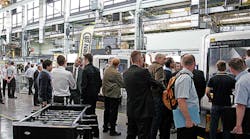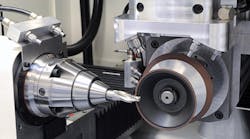Although manufacturing, as a whole, is experiencing a come-back, for machining and fabricating companies, the benefits are delayed. Further removed from the consumer, manufacturing contractors are slower to feel the subtle signs of today’s economic recovery. This slow organic growth is frustrating to many managers of machining and fabricating operations, who are eager for ways to jump-start more dramatic profit gains. Cloud deployment provides just the kind of agile start that growth-hungry machining and fabricating companies need.
For nearly two years, sparks of growth have been followed by disappointing dips in order volumes. According to the monthly U.S. Manufacturing Technology Orders report issued by AMT – the Association for Manufacturing Technology, the monthly total for new orders of machine tools and related products rose 12.6% from May to June, but the year-on-year results still show an overall drop.
The six-month total for 2014 machine tool orders dropped to $2,349.38 million, down 2.7% compared with the January-June 2013 total, AmericanMachinist reported. As order volumes vacillate, machining and fabricating operations find they cannot rely on economic recovery alone to return to pre-recession sales levels. Other tactics must be put in place if companies truly want to achieve dramatic growth.
Here are six tactics manufacturing technology companies can use to increase growth, each one of them made possible by cloud deployment.
1. Upgrade enterprise resource planning (ERP) solutions with a lower total cost of ownership. In order to accelerate rates of profitability, fabricating and machining companies need to take advantage of the modern functionality of today’s highly advanced ERP systems. Modern solutions offer greater visibility, the ability to stay connected through mobile devices and advanced reporting and decision-making tools.
With cloud deployment, companies can take advantage of these features, even if the recession drained their capital reserves. This is because cloud solutions have monthly subscription rates and can be covered as an operating expense, rather than a hefty one-time capital investment, making cloud an attractive financial option. Lower total cost of ownership is another long-term benefit, because the organizations doesn’t have to invest in servers or expensive security and IT support.
2. Enhance relationships with manufacturing partners. Success for machining and fabricating companies is tied largely to the manufacturers who subcontract work to them. Looking at this symbiotic relationship is one of the first steps to enhancing profitability. Visibility is key to the relationship, as is easy sharing of data and collaborative abilities. ERP solutions, deployed through the cloud, offer online portals and shared networks that can enhance communication with manufacturing partners. Orders, forecasts, inventory levels and production schedules can be easily shared to expedite the workflow and improve efficiency.
As manufacturers learn to adapt better to an extended supply chain, they will undoubtedly also need to monitor better the extended network of suppliers, contractors, and partners. A complete, real-time view of the end-to-end value chain will be essential to creating the collaborative and customer-centric approach needed to be competitive today. “Having a full picture of supply, demand, and capacity across all levels of their supply chain will enable future manufacturers to get trading partners working together more effectively, stimulate collaboration, maximize responsiveness, and improve performance,” declared an IDC analyst in the recent The Future of Manufacturing whitepaper.
That report also adds that full end-to-end supply chain visibility is an ambitious goal, as almost half of surveyed manufacturers say their current supply chain visibility ends at their immediate suppliers. Clearly, extensive work needs to be done to improve real-time connectivity with a vast network of partners and stakeholders, including customers. Cloud deployment, with its unlimited bandwidth and flexible storage capabilities, supports this type of multi-pronged approach to communication, data storage and data sharing between enterprises.
3. From global to local. The global economy is evolving at a remarkable rate. The market conditions that once made outsourcing and off-shoring such an attractive option for manufacturers seem to change daily—or with each breaking news bulletin. From 2006 to 2010, average real wages in China and India increased 75% and 175%, respectively, and in January 2014, Bloomberg News reported minimum-wage workers in Shenzhen, Guangdong province received a 13% boost, while those in Yangzhou, Jiangsu province received a 15.6% raise.
The changing labor costs, coupled with grassroots public demands for manufacturers to boycott countries with unsafe employee working conditions, have made many manufacturers reconsider their strategies for subcontracting machining and fabricating work.
The high cost of transportation and the consumer demand for accelerated delivery and service also help make the case for relocating fabricating and machining operations closer to the manufacturing operations, distribution hubs and the end consumer. In addition, moving fabricating locations helps place contract operations in closer proximity to product designers and engineers, helping the collaborative and consulting abilities.
Launch and Grow
Shifting the supply chain creates opportunities for new contracts and new partnerships—but a limited window of opportunity requires fast set-up and deployment. Cloud deployment allows partnering companies to set up new branches, divisions and distribution centers without the time and expense of researching, investing, implementing, and supporting an extensive infrastructure of hardware, customized software and servers. This enables the new location to be operational in weeks, not months.
4. Agility in mergers and acquisitions. For manufacturers turning to mergers and acquisitions as a growth tactic, speed is an important consideration. Many companies, frustrated with the slow rate of organic growth, are turning to M&A as a way to catapult to a higher plateau or to align better with changing customer demands. “With the economic recovery expected to be slow going and to offer a challenging environment organic growth potential, especially in mature markets such as the United States and Europe, many companies are viewing mergers and acquisitions as essential to achieving growth targets. In a recent survey, nearly 45% of manufacturing participants said their company is highly likely to, or definitely will, contemplate M&A opportunities in the next 12 to 18 months,” a recent Deloitte report stated.
Last month AmericanMachinist cited several recent examples of acquisitions by companies in different niches of manufacturing technology and suggested that this is an indicator of long-term growth for the industry. “While demand for machine tools and cutting tools has been tepid for most of the past year, there is one indicator suggesting long-term growth for manufacturing technology: mergers and acquisitions,” according to that report.
In order to minimize disruption to the core business and maintain visibility of multiple operations after the merger, one integrated end-to-end system needs to be deployed as quickly as possible. Lengthy implementation timetables typically involved in on premise deployment often means delays in realizing the return on investment of the merger or acquisition. Cloud deployment speeds this process, providing the full benefits of the M&A effort.
5. Customer-centric approach — Discussions about reinventing manufacturing almost always include a heightened emphasis on meeting customer expectations. The need for a customer-centric business model has permeated nearly every segment of manufacturing, from consumer packaged goods to metal fabrication. Today’s customer, whether it is a B2B or B2B2C business model, have extremely high expectations, little brand loyalty and they voice any disappointment loudly through social channels.
In order to meet these expectations, manufacturers are increasingly turning to advanced ERP solutions to help streamline the complexity, making even highly configured, mission-critical products more profitable to produce. With cloud deployment, manufacturers can spend more time on the product innovation and customer relationships, and less time on managing the implementation and IT infrastructure.
6. End the modification merry-go-round — Manufacturers and their contractors have a challenging road ahead with many obstacles in the way, and some of those roadblocks will be difficult to control. There is one challenge, though, that they can easily turn over to highly reliable third-party resources. Cloud deployment completely eliminates the need to maintain and upgrade software versions to stay on top of fast-changing IT innovations. The time consuming and costly need to update software is completely eliminated with cloud deployment, letting the solution provider and hosting company bear that burden. They also focus on security and sustainability, ensuring that backups are readily accessible and security threats are continually monitored and addressed.
How does delegating this important role to a third party help a manufacturer achieve greater growth? There are two answers: without this continual upgrade distraction, companies will have the resources to focus on other issues; and, they will have the most up-to-date tools to help them outperform the competition. These two benefits will give fabricators and machinists a valuable competitive edge as they move forward in the new era of re-defined manufacturing.
What’s ahead for cloud-savvy machinists and fabricators? As manufacturers and their contracting partners brace for the next stage of evolving industrialization, it is clear that many changes lie ahead and technology will be integral factor to those changes, the outcome and the coping methods. Cloud deployment, because of its flexibility, agility and subscription pricing, offers definite advantages to growth-hungry companies ready to move to the next level of customer satisfaction, product innovation, and global competitiveness.
What happens once manufacturers arrive in the cloud is up to them, and the insights they have gathered during previous restructurings and realignments. Will they be able to use this advantage to regain market-share, bring jobs back to communities, manage change, and build new collaborative models of creative problem solving? Will cloud deployment help elevate manufacturing to its previous place of dominance? Only time will tell, but it certainly appears as though this cloud, indeed, has a silver lining.
Larry Korak is the Director of Industry & Strategy, Industrial Manufacturing at Infor, a developer of enterprise software ranging from financial systems and resource planning to supply chain and customer relationships.










